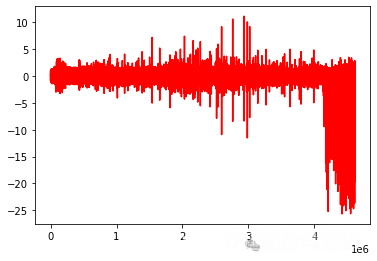代码较为简单,很容易读懂。
Importing the required libraries
import os
import numpy as np
import pywt
import pandas as pd
import pickle as pkl
from matplotlib import pyplot as pltParameters or Required Variables
DATA_POINTS_PER_FILE = 2560
TIME_PER_REC = 0.1
SAMPLING_FREQ = 25600 # 25.6 KHz
SAMPLING_PERIOD = 1.0/SAMPLING_FREQ
WIN_SIZE = 20
WAVELET_TYPE = 'morl'Helper Functions
def load_df(pkz_file):
with open(pkz_file, 'rb') as f:
df=pkl.load(f)
return df# perform CWT on 1d signals and return 2d feature image
def extract_feature_image(ind, feature_name='horiz accel'):
data_range = df_row_ind_to_data_range(ind)
data = df[feature_name].values[data_range[0]:data_range[1]]
# use window to process(= prepare, develop) 1d signal
data = np.array([np.mean(data[i:i+WIN_SIZE]) for i in range(0, DATA_POINTS_PER_FILE, WIN_SIZE)])
# perform cwt on 1d data
coef, _ = pywt.cwt(data, np.linspace(1,128,128), WAVELET_TYPE)
# transform to power and apply logarithm ?!
coef = np.log2(coef**2+0.001)
# normalize coef
coef = (coef - coef.min())/(coef.max() - coef.min())
return coefmain_dir = ''pkz_file=main_dir+'bearing1_3.pkz'
df=load_df(pkz_file)
df.head()
Printing total data points and total no. of data files present in a pickle(.pkz) file
no_of_rows = df.shape[0]
no_of_files = int(no_of_rows / DATA_POINTS_PER_FILE)
print(no_of_rows, no_of_files)Plotting 1D vibration signals(both horiz accel and vert accel)
plt.plot(range(no_of_rows), df['horiz accel'])
plt.show()
plt.plot(range(no_of_rows), df['vert accel'], 'r')
plt.show()

signal processing = Extracting Time-Frequency Domain feature images
no_of_samples=5
fig, ax = plt.subplots(2, no_of_samples, figsize=[20,8])
ax[0,0].set_ylabel('horiz accel features image')
ax[1,0].set_ylabel('vert accel features image')
'''
dividing the feature images into 5 samples
'''
for i, p in enumerate(np.linspace(0,1,no_of_samples)):
ind = int((no_of_files-1)*p)
#extracting and plotting horizontal acceleration feature images (horiz accel feature images) for 5 samples (0.00, 0.25, 0.50, 0.75, 1.00).
#horiz accel => horizontal acceleration vibration signal
coef = extract_feature_image(ind, feature_name='horiz accel')
ax[0,i].set_title('{0:.2f}'.format(p))
im = ax[0,i].imshow(coef, cmap='coolwarm')
fig.colorbar(im, ax=ax[0,i], fraction=0.046, pad=0.04)
#extracting and plotting vertical acceleration feature images (vert accel feature images) for 5 samples (0.00, 0.25, 0.50, 0.75, 1.00).
#vert accel => vertical acceleration vibration signal
coef = extract_feature_image(ind, feature_name='vert accel')
ax[1,i].set_title('{0:.2f}'.format(p))
im = ax[1,i].imshow(coef, cmap='coolwarm')
fig.colorbar(im, ax=ax[1,i], fraction=0.046, pad=0.04)
'''
The tight_layout() function in pyplot module of matplotlib library is used to automatically adjust subplot parameters to give specified padding.
padding = adding space (adding required white space)
'''
plt.tight_layout()
'''
The show() function in pyplot module of matplotlib library is used to display all figures.
'''
plt.show()
工学博士,担任《Mechanical System and Signal Processing》《中国电机工程学报》《控制与决策》等期刊审稿专家,擅长领域:现代信号处理,机器学习,深度学习,数字孪生,时间序列分析,设备缺陷检测、设备异常检测、设备智能故障诊断与健康管理PHM等。